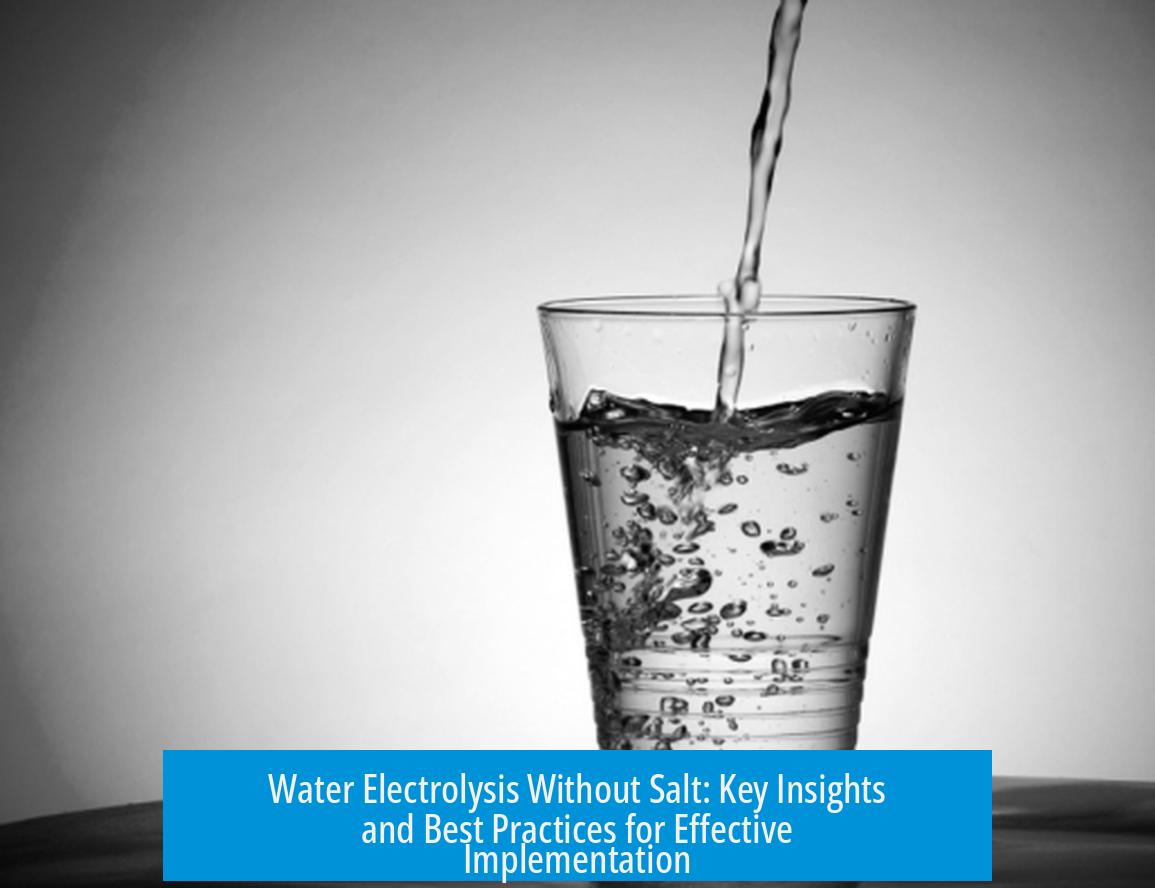Water Electrolysis Without Salt: Understanding the Process and Challenges

Water electrolysis without salt is technically possible but highly inefficient because pure water has very low electrical conductivity. It requires a high voltage and excessive energy to drive the electrolysis process without adding an electrolyte to enhance conductivity.
Why Electrolyzing Pure Water is Difficult
Pure or distilled water contains very few ions, leading to low electrical conductivity. This hinders the flow of current during electrolysis. Consequently, more electrical energy is needed to overcome this resistance and separate hydrogen and oxygen from water molecules. The energy required to split water molecules remains constant, but extra energy is needed just to move the electric current through the poor conductor.
As a result, the electrolysis of pure water demands very high voltages and is considered inefficient. Although the fundamental chemical reaction is straightforward:
2H2O (l) → 2H2 (g) + O2 (g)
its practical implementation without added electrolytes is limited.
The Role of Electrolytes in Water Electrolysis
Adding an electrolyte significantly improves the conductivity of water, facilitating the flow of electrical current. This reduces the energy needed to drive electrolysis and increases overall efficiency. Electrolytes dissociate into ions, effectively transporting charge between electrodes.
However, not all electrolytes are suitable. The chosen compound should enhance conductivity without producing undesired side products during electrolysis.
Electrolytes Suitable for Salt-Free Water Electrolysis
Common table salt (NaCl) is typically avoided due to chlorine gas formation at the anode, which is hazardous. Instead, safer electrolytes include:
- Alkali Sulfates (Sodium or Potassium Sulfate): These are inexpensive and readily available salts. Their ions are stable and do not easily undergo oxidation or reduction, allowing clean hydrogen and oxygen production.
- Diluted Sulfuric Acid: Adding a few milliliters of 98% sulfuric acid substantially increases conductivity. Sulfuric acid is highly conductive but requires careful handling due to its corrosive nature.
- Alkali Hydroxides (Sodium Hydroxide): These strong bases enhance conductivity. Even diluted, they can cause serious chemical burns, so strict safety precautions are necessary.
- Baking Soda (Sodium Bicarbonate) and Sodium Hydrogen Sulfate: These milder electrolytes improve conductivity without producing chlorine gas, making them relatively safer options.
Choosing the Right Electrolyte: Stability Matters
For efficient and safe electrolysis, the electrolyte’s ions must be more stable than water molecules, preventing them from decomposing during the reaction. When this condition is met, the electrolysis produces only hydrogen and oxygen gases. For example, alkali sulfates and diluted sulfuric acid meet this criterion. Using unstable ions may lead to side reactions and formation of unwanted gases.
Impact of Electrolyte Choice on Electrolysis Outcome
| Electrolyte | Effect on Conductivity | Byproducts | Safety Considerations |
|---|---|---|---|
| Sodium or Potassium Sulfate | Moderate increase | None | Generally safe |
| Diluted Sulfuric Acid | High increase | None | Corrosive; requires handling precautions |
| Sodium Hydroxide | High increase | None | Strong base; harmful upon contact |
| Baking Soda (Sodium Bicarbonate) | Moderate increase | None | Safe and easy to handle |
| Common Salt (NaCl) | High increase | Chlorine gas (hazardous) | Not recommended |
Electrode Material Choices for Efficient Electrolysis
Electrode durability is a critical factor. Even without salt, electrodes may corrode over time, affecting performance.
Recommendations include:
- Stainless Steel: Commonly used due to moderate corrosion resistance and availability. Suitable for low to moderate currents.
- Graphite Electrodes: Effective for high current applications. However, quality graphite is necessary; inexpensive materials from batteries are inadequate.
- Platinized Titanium Electrodes: The best option for long-term use. These are highly resistant to corrosion and last for thousands of hours. Their cost is higher but justified by durability.
Summary of Water Electrolysis Without Salt
- Pure water electrolysis is achievable but extremely inefficient due to low conductivity.
- Adding an electrolyte greatly improves electrical conductivity, lowering energy consumption.
- Electrolytes such as sodium sulfate, potassium sulfate, diluted sulfuric acid, and baking soda are preferred over common salt to avoid hazardous chlorine gas.
- The electrolyte ions must be more stable than water to prevent interfering reactions.
- Electrode materials must resist corrosion; platinized titanium is optimal for longevity and efficiency.





Leave a Comment